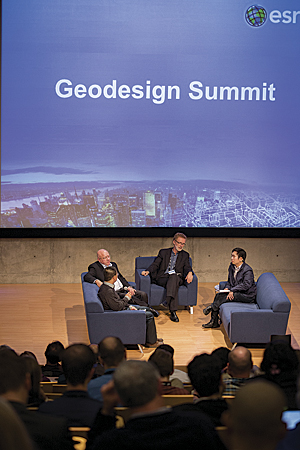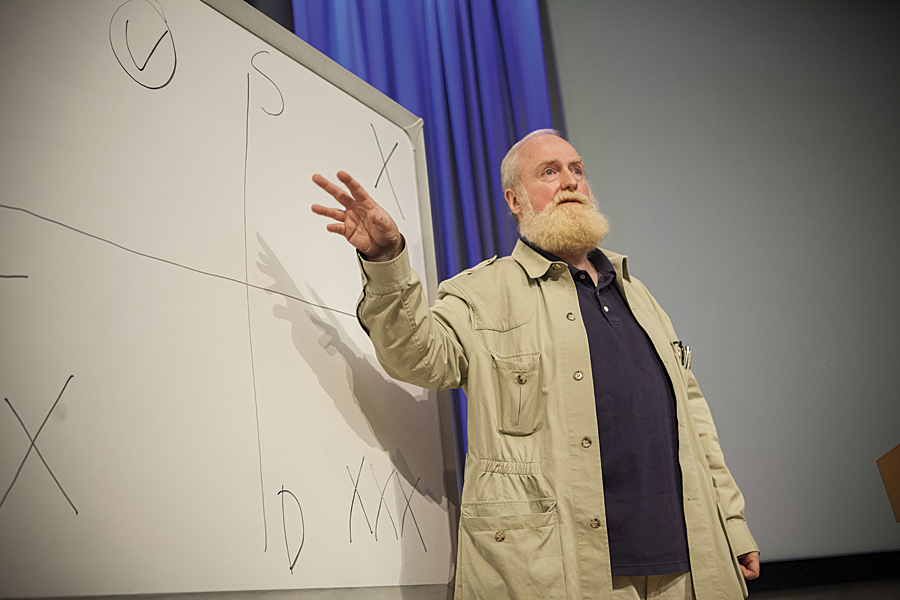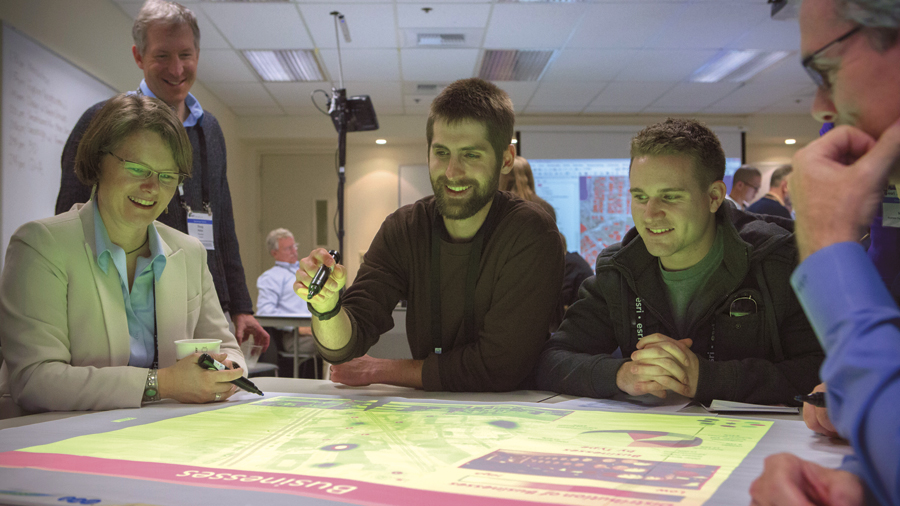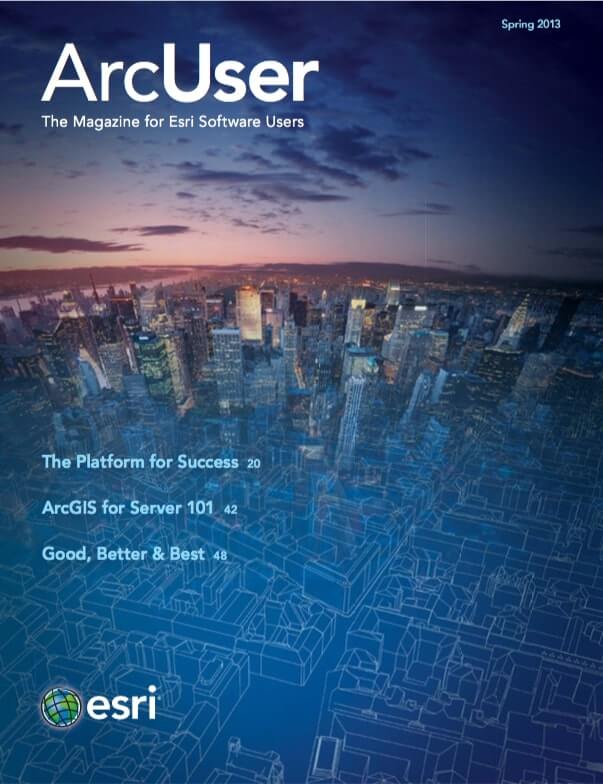Crafting smart, sustainable solutions to big problems
Geodesign, the subject of a two-day summit held at Esri in Redlands, California, has become more than a buzzword. It is changing how projects are planned and has become a recognized academic discipline.
The Geodesign Summit, only in its fourth year, drew a record 260 attendees, including architects; urban and transportation planners; educators; and GIS, environmental, and design professionals from the United States and abroad.

Geodesign couples geography with design. Practitioners use both creative design techniques and geospatial technologies, such as GIS, to come up with design options to consider and eventually arrive at smart, sustainable solutions.
One attendee, Breece Robertson, is the national GIS director for the Trust for Public Land. She sees geodesign as a collaborative process that involves many stakeholders. “The words iterative, futuristic, and impacts come to mind as but a few of the key components that are involved in the geodesign process,” she said. “I think a lot of us have been doing geodesign for a long time, but there is always room for improving our processes.”
“It makes design decisions data rich,” said Thomas Fisher, the summit’s moderator and a professor of architecture and dean of the College of Design at the University of Minnesota. “It takes GIS analysis into the future to [show] not only what is but what could be.”
One of the featured speakers was David B. Bartlett, who is known as the Building Whisperer. The vice president of IBM Smarter Buildings, his job is to help make places like school districts and universities more energy efficient. At the summit, he talked about the role data and location-based analysis plays in achieving this goal.
IBM partnered with Esri and CitySourced to create a crowdsourcing application for smartphones that students, teachers, and staff at the Los Angeles Unified School District can use to snap photographs of and record the location of broken windows and faulty air conditioners at schools. Fixing these problems quickly led to energy savings. [To learn more about this application, read “Smartphone App Aids District’s Facilities Maintenance” in the Spring 2012 issue of ArcUser magazine.]
In his talk “The Instant City—Geodesign and Urban Planning,” Elliot Hartley, director of Garsdale Design Limited in Cumbria, United Kingdom, described how his firm, along with its Iraqi Planners Group, is creating a master plan for the city of Nasiriyah, Iraq. This plan addresses future housing, utilities, and infrastructure. Using Esri CityEngine, 3D modeling software for urban environments, the firm was able to change plans when new data was added or late changes were made. Changes that had taken four days using other software took just a half day using CityEngine.

Modeling the Future
CityEngine and other Esri technologies were used to model the potential plans for mitigating the impacts of population growth and traffic congestion on the rapidly growing city of Honolulu, Hawaii. Esri solutions engineer Eric Wittner showed how Esri software modeled alternative futures for Honolulu. First, data was prepared using Esri ArcGIS for Desktop. Then 3D GIS data from Pictometry and PLW Modelworks, representing realistic building models for portions of the city, were combined in Esri CityEngine. CityEngine used a set of rules to generate a 3D representation of the city as it looks now and then model series of scenarios showing how the city might grow.
One scenario showed significant urban sprawl if thousands of new single-family homes were built outside the urban core. In another scenario was a much smaller footprint in undeveloped areas if the city built up rather than out, with people living in tall buildings near the multibillion-dollar light rail system planned.
Technology Matters
Esri president Jack Dangermond spoke to summit attendees about his enduring belief in technology as an agent of positive change to tackle the planet’s big problems. “In my life, I always believed technology could matter,” he said.
GIS is becoming a platform technology that is widely available via the cloud, which supports applications on the web and on mobile devices. “This potentially has the power of making the concepts of geography, the models, the analytics—not simply the visualization—available to everyone,” Dangermond said. For organizations, this means that geographic knowledge—including geodesign tools—will become available to a much wider audience than in the past.
This idea of GIS as a platform was brought home to the audience with demonstrations that showed the increasing simplicity of making online maps using ArcGIS Online and Esri Story Maps templates.
Esri technology evangelist Bern Szukalski gave the audience a sneak preview of Esri’s landscape analysis services, (currently in beta testing), geared specifically toward geodesign work. He used these services to study the solar generating potential of the Ivanpah Solar Electric Generating System, currently being built in the Mojave Desert. He analyzed the slope of the terrain and proximity to the habitat areas of desert tortoises in relation to the solar project’s location.
Tackling the Big Problems the Planet Faces
The summit’s keynote speaker designer and technologist Bran Ferren had also been the keynote speaker at the first Geodesign Summit. This time he delivered a challenge: Develop a 250-year plan for the planet enabled by geodesign to create a vision of the future.
“Geodesign combines geography and data with modeling, simulation, and visualization to tell stories and [show] the consequences of your actions,” Ferren said. He sees great potential for geodesign to ultimately help find solutions to complex problems. “It is still in the shiny object stage, but it will be very important,” he said.

Geodesign technology will mature naturally, much like GPS and other technologies have done. But meanwhile, says Ferren, in this era of short attention spans, people need to start thinking far into the future to create a problem-solving template that can be built upon over time. “If we are going to address these big global issues facing us—whether that’s disease, education, freshwater, war, or global warming—you actually have to take a long view,” Ferren said. He said we need to post questions such as, What is your current state of affairs or the topic you are worried about? What is your desired end state? and How are you going to get there?
“I argue that just having the discipline to sit down for a day and think about that will change your whole thought process,” Ferren said. “It doesn’t mean you are going to know exactly what the future is, but having a sense that in 250 years, you would like to address these things at least gives you an intellectual template and road map to test your ideas against.”
This process will be collaborative, according to Ferren. “That’s the power of geodesign,” he said. “It’s this network extension of shared intelligence where the insights of individuals can be shared among others and that can be used as the foundation to build upon.”
Ferren also said that geodesigners in the future will be entrusted with the same power over life and death that doctors have today because the decisions they make will be critical to humans and other species. “The mistakes you make in planning and designing our cities may take 100 years until someone understands the consequences of those actions. The Hippocratic Oath for geodesign: First, do no harm,” he said. “Understand what you are doing and the effect—if you know this is going to do long-term damage, it is not okay to do it. We aren’t on this earth very long. It’s a mere blip. Try to leave it a little better than how we found it.”
A Worthwhile Event
Ferren’s talk, the featured presentations, and the technology demonstrations were inspiring to many Geodesign Summit attendees such as Juan C. Perez, director of transportation and land management for the Transportation and Land Management Agency for the County of Riverside, California.
“The session that focused on the visual modeling and analytic tools when presenting land-use decisions to policy makers was excellent,” Perez said, adding that he would like Riverside County to use some of the tools.
Perez also said Ferren’s proposal of a 250-year plan was thought provoking. “While perhaps extreme at first blush, it really puts into perspective that the land-use decisions that we make have very long-term consequences.”
For more information, visit the Geodesign Summit webpage. Planning is under way for the Geodesign Summit Europe, September 19–20, 2013, at the GeoFort in Herwijnen, the Netherlands.

